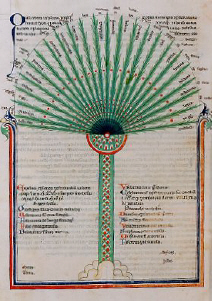WHAT IS BEING IN THE INTELLIGIBLE IS GENERATION IN THE SENSE-WORLD.
2. First let us consider what mundane name “Being” must be applied to. To begin with, it must be explained that physical nature can receive the name of “being” only as a figure of speech;1 or rather, should not receive it at all, since it implies the idea of perpetual flowing (that is, change7); so, the more suitable denomination would be “generation.”8 We shall also have to acknowledge that the things that belong to generation are very different; nevertheless all bodies, some simple (such, as elements), the others composite as mixtures), together with their accidents and effects, must, during the process of classification, be reduced to a single genus.
– In bodies, one may besides distinguish on one hand matter, on the other, the form imprinted thereon; and we designate each of these separately as a genus, or subsume both under a unity, inasmuch as we designate both by the common label1 of “being,” or rather, “generation.” But what is the common element in matter and form? In what manner, and of what is matter a genus? For what difference .inheres in matter? In what sequence could we incorporate that which is composed of both ? But in the case that that which is composed of both be itself corporeal being, while neither of the two is a body, how then could either be incorporated in a single genus, or within the same genus along with the compound of both? How (could this incorporation into a single genus be effected with) the elements of some object and the object itself? To answer that we should begin by the (composite) bodies: which would be tantamount to learning to read by beginning with syllables (and not with letters).
CAN WE ANALYZE THIS WORLD BY ANALOGY WITH THE INTELLIGIBLE?
Let us now grant that symmetrical analysis by individual objects is impossible. Might we not, as a means of classification, then employ analogy? In this case the (intelligible, higher) “being” would here be represented by matter; and movement above, by form here, which would thus quicken and perfect matter. The inertia of matter would correspond to rest ^above, while the (intelligible) identity and difference would correspond to our earthly manifold resemblance and differences.9 (Such an analogic method would misrepresent the state of affairs in this world). To begin with, matter does not receive form as its life or actualization, but (form) approaches and informs (matter) as something foreign (form deriving from being, while matter is only a deception; so that there is no kinship between them). Then in the (intelligible world) form is an actualization and motion, while here below movement is different, being accidental; we might far rather call form the halting or rest of matter, for form defines that which in itself is indefinite (unlimited). There (in the intelligible world) identity and difference refer to a single essence, which is both identical and different. Here below, essence differs only relatively, by participation (in the difference) for it is something identical and different, not by consequence, as above, but here below, by nature. As to stability, how could it be attributed to matter, which assumes all dimensions, which receives all its forms from without, without itself ever being able to beget anything by means of these forms? Such a division, therefore, will have to be given up.
